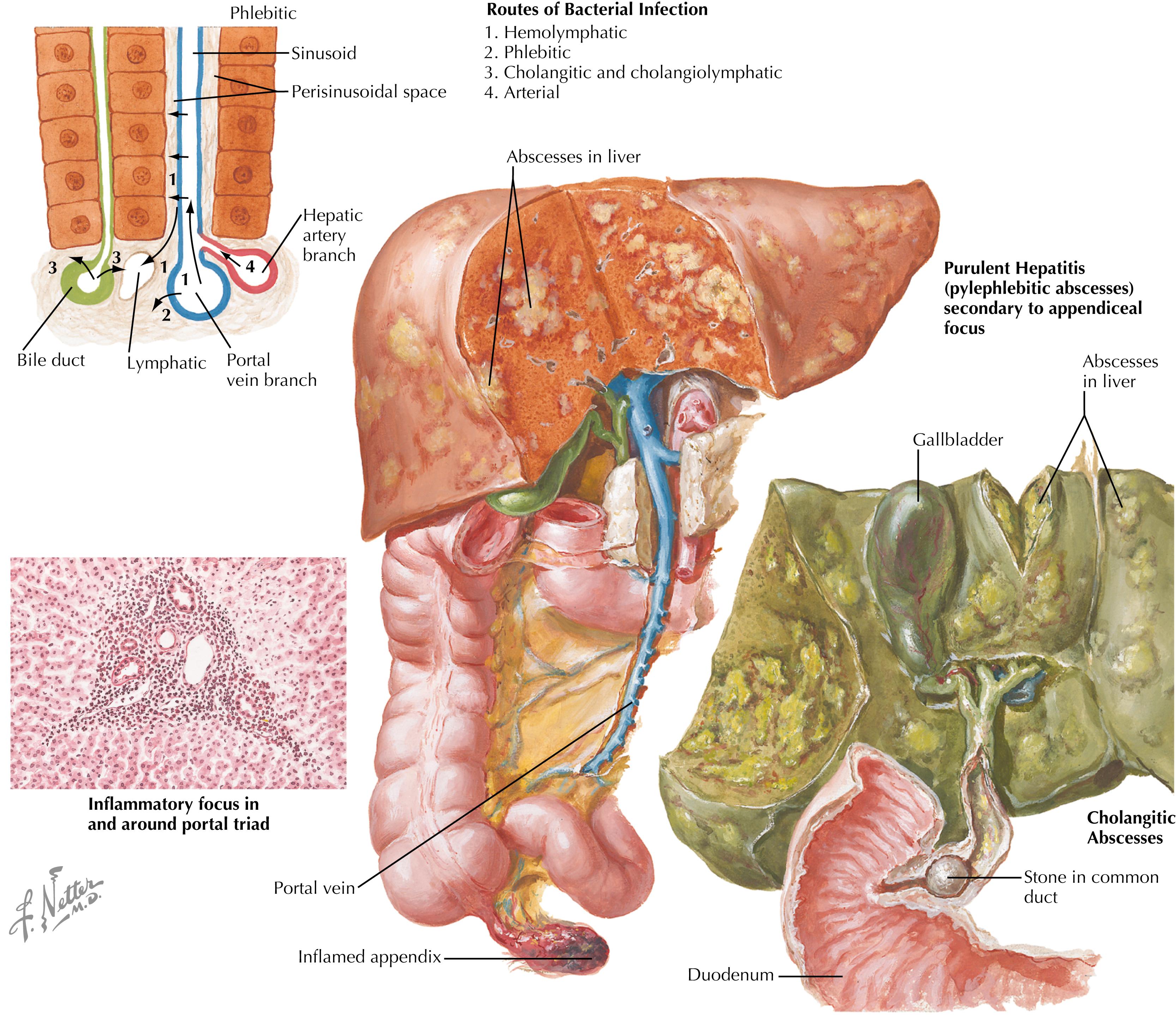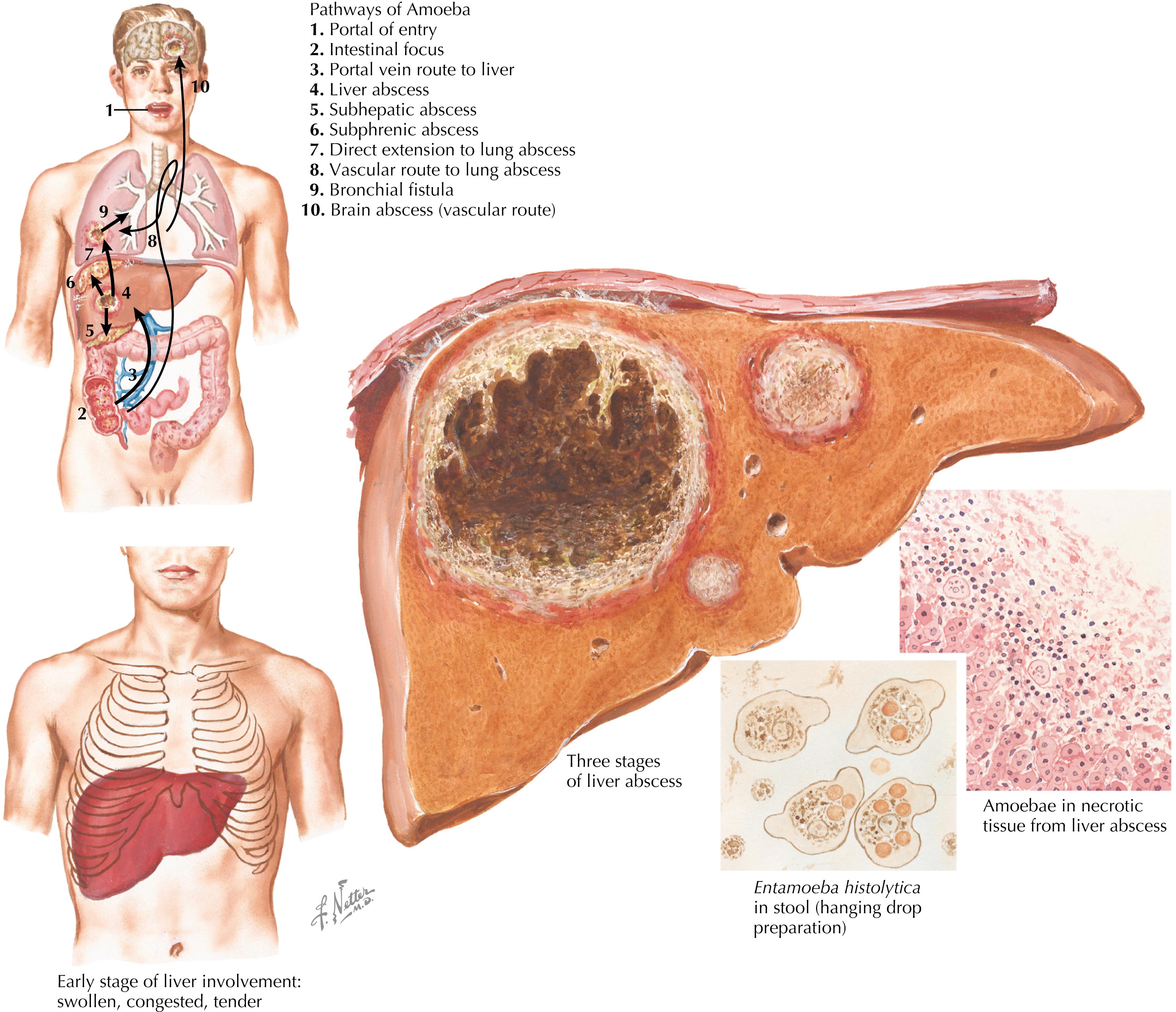Physical Address
304 North Cardinal St.
Dorchester Center, MA 02124
Liver abscess is comprised of two main types: pyogenic and amebic. The most common type is pyogenic, which usually results from biliary and intra-abdominal infections. On the other hand, amebic liver abscess occurs far less frequently and is a complication of Entamoeba histolytica infection. Both abscess types present in a similar manner, often manifesting vague and nonspecific symptoms, necessitating a high index of suspicion for prompt diagnosis and treatment. Ultrasonography and computed tomography, along with culture and serology, correlated to clinical signs and symptoms, aid in establishing the diagnosis. Treatment of pyogenic liver abscess requires antimicrobial therapy and percutaneous drainage, with surgical drainage reserved for treatment failures or for patients undergoing simultaneous treatment of an intra-abdominal source. In contrast, amebic liver abscess responds well to amebicidal treatment and rarely requires drainage. Outcomes depend on the severity of illness at presentation, presence of underlying malignancy, and need for surgical drainage.
A 42-year-old man presents with gradually worsening right-sided abdominal pain, fatigue, and anorexia. On further history, he is noted to have several weeks of intermittent fevers, general malaise, and occasional severe right upper quadrant pain after eating. He is obese but without other medical problems. He is a heterosexual male without drug use or significant travel history.
On physical examination, he has a heart rate of 109, blood pressure 130/84, respiratory rate of 20 breaths per minute, temperature of 37.5°C, and 97% oxygen saturation on room air. He is alert, oriented, tired appearing, and otherwise unremarkable, except for an obese abdomen, which is tender to deep palpation throughout the right upper quadrant without rebound tenderness. He has no hepatomegaly on percussion or palpation.
Significant laboratory values include a white blood cell count of 13,000/µL, alkaline transaminase (ALT) 109 µ/L, aspartate transaminase (AST) 95 µ/L, and bilirubin 0.9 mg/dL.
A right upper quadrant ultrasound demonstrated a right lobe predominant hyperechoic; a loculated lesion in the liver as well as cholelithiasis, without evidence of cholecystitis; and a positive Murphy sign. As a result of the abscess findings, a computed tomography (CT) scan was performed of the chest, abdomen, and pelvis, which revealed a small simple right pleural effusion and a rim enhancing loculated cystic lesion in the right lobe of the liver.
Treatment was initiated with piperacillin/tazobactam, and percutaneous drainage was performed by interventional radiology with the placement of a pigtail drain. The patient was admitted to the acute care surgery service, and the following day, cultures revealed Klebsiella pneumoniae and Escherichia coli . He was discharged with 4 weeks of ciprofloxacin and drain removal in a clinic.
Pyogenic liver abscess is the predominant (>80%) form of liver abscess and accounts for the majority of visceral abscesses. Its incidence has risen in the last three decades, currently estimated between 2.9 and 3.6 per 100,000 population years in the United States. It is more prevalent in Southeast Asia, and a primary invasive liver abscess syndrome caused by Klebsiella pneumoniae has been described most commonly in this region. Approximately 10% of the world’s population (50 million annually) is infected with Entamoeba histolytica, with the majority of cases occurring in developing countries. Amebic liver abscess is the most common form of extraintestinal manifestation of amebiasis.
Identifying the underlying source of the liver abscess is important for prompt recognition of this challenging diagnosis, aiding in accurate prognostication and complete treatment of the disease. For pyogenic abscess, etiologies include biliary disease, portal venous seeding from gastrointestinal infections, bacteremia from external sites, direct extension from either right upper quadrant abscesses, and liver trauma ( Fig. 47.1 ). The cause of pyogenic liver abscess often results from ascending infection due to biliary disease or from portal pyemia due to peritoneal infection. Moreover, procedures like endoscopic retrograde cholangiopancreatography (ERCP), percutaneous transhepatic cholangiography (PTC), or surgical biliary reconstruction can introduce microorganisms into the liver and predispose to hepatic abscess formation. Intra-abdominal infections such as appendicitis and diverticulitis are well-known sources of liver abscess via portal venous seeding. Hematogenous arterial seeding can occur from extra-abdominal sites such as in infective endocarditis or intravenous drug use. Suppurative cholecystitis and perforated peptic ulcers may lead to hepatic abscess via direct extension. Pyogenic liver abscess formation through direct inoculation of microbes into devitalized liver tissue from blunt or penetrating liver trauma or following thermal ablation using either radiofrequency ablation (RFA) or microwave ablation (MWA) of liver tumors is an increasingly recognized etiologic mechanism. A small subset of patients will have cryptogenic hepatic abscess without an identifiable source.

Amebic liver abscess is an extraintestinal complication of E. histolytica dysentery, which is transmitted via a fecal-oral route. Amebiasis results from the ingestion of cysts of the protozoan E. histolytica , which liberate the trophozoite form of the parasite in the intestine ( Fig. 47.2 ). In complicated cases, intestinal wall invasion and subsequent seeding of the liver via the portal vein occur. In the liver, the trophozoites cause an acute inflammatory response that results in granuloma formation and liver necrosis, leading to the classic “anchovy paste” amebic liver abscess.

Become a Clinical Tree membership for Full access and enjoy Unlimited articles
If you are a member. Log in here